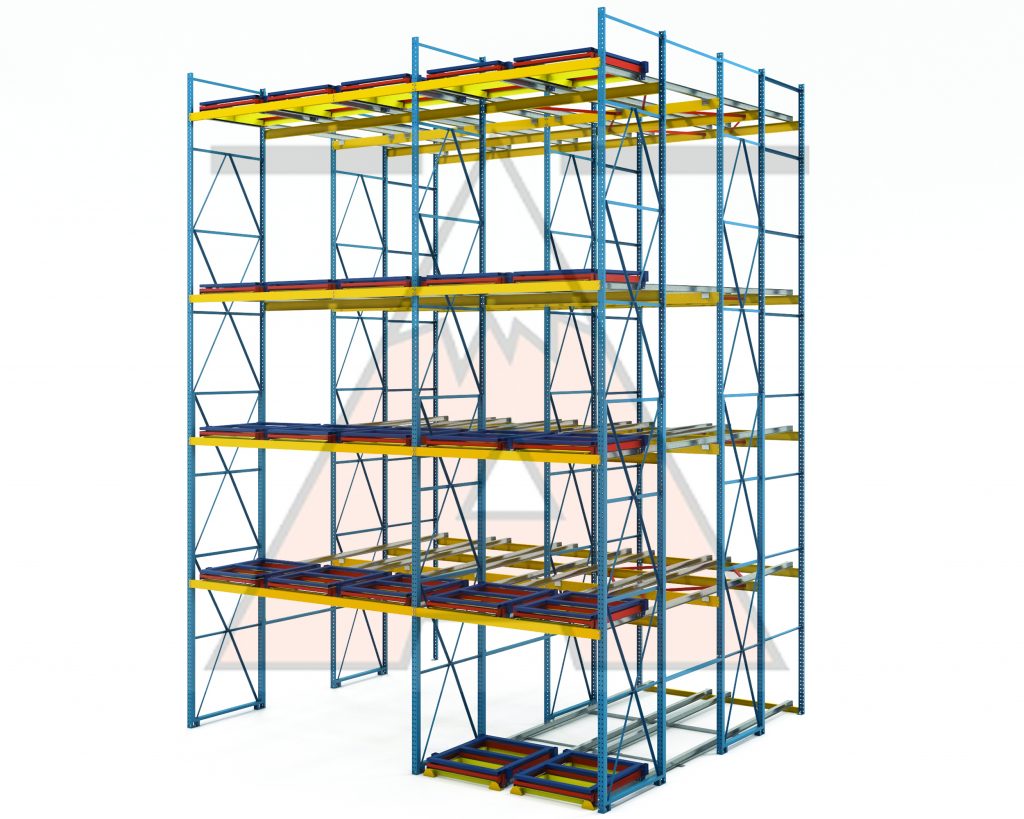
Pallet rack row spacers can take the form of steel bars, channels, or rods. They come in a variety of shapes and sizes and can be painted, unfinished or galvanized. They connect upright to upright in configurations where rows of pallet rack are positioned back-to-back while allowing space between them. Why is any of that important?
Row Spacer Functions
- Maintain the longitudinal flu space required for fire code compliance
- Add stability to the rack rows and shore up against forklift strikes
- Keep rows plumb and in line for an orderly rack configuration
- Heavy-duty/structural spacers help stabilize back-to-back pallet rack & high-density systems
Fire Protection & Rack Safety
Fire safety and code compliance are vital in warehousing facilities. Overhead sprinkler systems are designed to allow water to reach all rack levels and inventory. To do that in a back-to-back rack configuration, flue spaces must be created between the rear of the two rack structures. Row spacers are instrumental in serving as a stabilizing mechanism to support the two systems. Since they cannot be braced against each other the row spacer acts as that stabilizing unit and keeps that vital flue space intact.
Sizing Up Row Spacers
 Choosing the right size row spacer is important. Standard sizes of row spacers are 6″, 8″, 10″, 12″, 14″, and 18″. The 12” row spacer is most common with a 42” deep pallet rack, and 6” is the most common with a 48” deep rack. A common vertical flue space requirement is 6” though fire codes must be confirmed for each application individually. If there’s no pallet overhang in the rack design, then a narrower row spacer can be used. Wider spacers are often used to tie racks together around warehouse columns.
Choosing the right size row spacer is important. Standard sizes of row spacers are 6″, 8″, 10″, 12″, 14″, and 18″. The 12” row spacer is most common with a 42” deep pallet rack, and 6” is the most common with a 48” deep rack. A common vertical flue space requirement is 6” though fire codes must be confirmed for each application individually. If there’s no pallet overhang in the rack design, then a narrower row spacer can be used. Wider spacers are often used to tie racks together around warehouse columns.
To determine how long a row spacer is, measure the length between the flanges. For example, a 12” spacer has a full 12” in the center of the spacer.
Attaining New Heights
Heavy-duty/structural row spacers can be used in a shorter rack to provide added stability and rigidity, but they are required for tall rack where the height-to-depth ratio would exceed the recommended ANSI/RMI 6-to-1 Ratio (Total Rack Height divided by 240).
The 6-to-1 ratio is defined as the height-to-depth ratio for a single rack row as “the ratio of the distance from the floor to the top beam level divided by the depth of the upright.” This ratio cannot exceed 6-to-1 without engineering review.
Back-to-back pallet rack configurations with a height-to-depth ratio of 6:1 or greater need row spacers a minimum of 8’ to 10’ apart from each other to bring the rack system into compliance by providing the necessary stabilization.
Row spacers should be positioned at brace panel points starting at the second horizontal upright brace elevation (approx. 48”- 60” from the ground) and then at every second horizontal brace panel point thereafter (approx. 84” to 108” spacing). Flue spaces 24” or wider will need heavy-duty spacers with additional hardware requirements. Heavy-duty spacers are normally used in conjunction with a heavy-duty bottom horizontal strut.
High-Density Pallet Storage
Row spacers are used in high-density pallet storage systems to create the frame line that allows for the depth of a deeper lane system. A series of uprights, columns, and row spacers make up an upright line in a push-back, drive-in/thru, pallet flow, and pallet shuttle system. The image below shows a 4-deep push-back rack system using the following upright line; upright – row spacer – upright – row spacer – single column at the back.
Installation Tips
 First, be sure to choose the right size row spacer and ensure the style of row spacer meets the system design… i.e. rated for roll-formed or structural rack systems.
First, be sure to choose the right size row spacer and ensure the style of row spacer meets the system design… i.e. rated for roll-formed or structural rack systems.
Structural spacers, for example, are engineered to firmly secure both rack rows, thereby minimizing the number of anchors and reducing the size of the baseplate.
Ensure the rack is plumb and level before tightening nuts and bolts. Extra care must be exercised to avoid interference with struts, rack beams, and other components.
Maintaining the Safety of the Rack
Just like any other system component, row spacers can see warehouse traffic damage. A damaged row spacer can create stability issues and even structural issues if it cannot perform its proper function. Always be sure to have damage assessments and repairs reviewed and approved by certified rack repair specialists.
The Apex team can be with you every step of the way to ensure your pallet rack systems are safely designed, installed, and functioning as intended. Give us a call today to discuss your warehousing needs and challenges.


